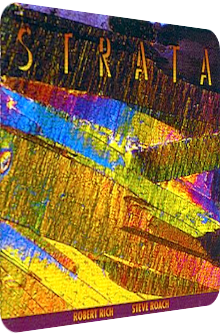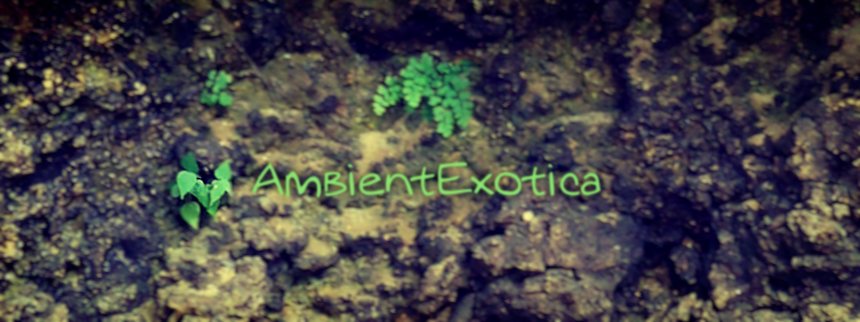
Robert Rich & Steve Roach
Strata
1990
When is the genre of New Age used as an insult? And why does it occasionally wear a positive connotation? Well, it‘s because of people like me, I have to admit, who link two distinctive attributes to the genre: it‘s either faux-indigenous or -autochthonous music with chanting aborigines, archival sound footage of rainforest ambience and placid drums that need to be as exotic as they probably can, or it is much more technology- and synthesizer-related, depicting blissful adventures in a cyberspace highlighted in neon technicolors and the palmy days of warped hallucinations – think about Christelle Gualdi‘s Stellar OM Source music project or the penultimate scene of Stanley Kubrick‘s 2001: A Space Odyssey, and you know what kind of colors I‘m referring to. Robert Rich is such an Ambient musician who releases music since the early 80‘s on labels that either floated into the maelstrom of obscurity or are to this day closely associated with the New Age genre of the indigenous kind. Steve Roach likewise releases electronic music since the early 80‘s and comes up with Ambient travelogs and journeys which the listener undertakes in order to become a new-born human again. If that does turn you off, you‘re in good company, since I would be thinking twice before listening to, let alone buying the immense back catalog that both artists have to offer. However, there is this moment where all of a sudden both artists influence each other for good: Strata from 1990 and the 1992 follow-up Soma are these moments. The only remainders of the New Age spectrum are the tribal drums – usually found in the Exotica genre where they make much more sense –, a few acoustic guitar pluckings and the kind of programmed synthesizer that encapsulates mystical reverberation as well as pristine clarity in the way it is set up. Strata means layers, and refers twofoldly to the different sediments of the Earth as well as to the multiple textures that are put on top of each other. All 10 songs flow and aren‘t loop-based, making this the kind of organic album that almost crosses the line of New Age territory, but is in my opinion more of a proper Ambient release.
Fearless is the ethereal gateway to the world of Strata, and as if my above explanation would be ridiculed by the duo, the song starts with tribal drums. Okay. But the synth work of Roach is clearly recognizable, inheriting the elysian rapture and a darker undertone as a permanent inrush. Quavering Pandean pipes are added, but they enhance the setting of mystique rather than carrying the weight – or lightness – of New Age topoi. A gorgeously haunting prelude. Mica starts with even bolder drums, inducing the setting of a jeep driving down a jungle road. Wild beasts are occasionally snorting in the background. The fuzzy marimba-like synth amplifies the feeling of being in a jungle that is dangerously beautiful. When tenuously gloomy synth strings are added in the second half, their baneful character evokes a dusky atmosphere. The nine minute long The Grotto Of Time Lost is next, and it is good track with a few weak ingredients. The title alone points you into the right direction, and your expectations won‘t be disappointed: water droplets and fragile angelic synth structures paint a place of quiescence. It is after almost three minutes that reverberated steel guitar strings bring life to the track. However, while the track remains beatless and Ambient in nature, the angelic synth strings are played sky-high and are thus too cherubic for my taste. The character of the tune moves dangerously close to New Age realms, and while I don‘t mind a soft ecclesial thread being interwoven in Ambient music, the heaviness in The Grotto Of Time Lost is too much for me. The following Iguana picks up where Mica has left with the same instrument setups and sound fragments reminiscent of a deep jungle. However, the synth washes are much more in the limelight now, towering angrily above the setting. Even though they fade out quite often, they always come back, much more spectral and eerie, but at times serene as well.
If there is one especially song worth mentioning, it is Magma, which is the best song of the album, period. Rich & Roach create a droning abyss with dark synth strings, rumbling drones, warped iron chain- or cowbell-like layers and portentous fizzles. This is a strangely soothing Ambient track, even though all the layers are used to depict the raw power of elemental forces. The feeling of uneasiness can never be shaken off entirely, but I for one like the bustling activities of each layer, there is always something going on, spluttering fire over here, vibrating drones over there, rattling chains in the background and so on. The dungeon, volcano or caldera is perfectly believable. Unfortunately, Magma is the only song whose setup is cineastic. The next track, Persistence Of Memory (For Dalí), goes back to arcane territories: terrifically mellow synth strings, dynamic cymbals, warm static noise fragments and howling strings similar to a flute make this a surprisingly warm track that is less mysterious than sanguine … in a solemn way, naturally. This is yet another favorite of mine. While Remembrance, the shortest track of the album, features owl-like sounds and echoey steel guitar strings which are intertwined with multitextured synth pads that sound like pitched down bells, Ceremony Of Shadows delivers a quirky, pre-Acid galactic nucleus. Quirky pulses, temple gongs, dark flutes and whispering voices take the listener to a Far Eastern territory by night. This is yet another strong track, if only for its flow that floats along peacefully. Rich & Roach focus more on the aura than on the music-related aspect. If I didn‘t know better, I would have thought of this track as a field recording. The 10+ minute long beatless outro La Luna remains in Far Eastern lands and starts with sublimely glacial synth strings, Japanese zithers, darkly droning temple gongs and meandering bass quakes. The mood never changes or strays away, allowing the listener to get fully immersed with the moonlit aura. La Luna is an appropriate closer to a mercurial album.
The first conclusion I need to make is in regard to the awe-inspiring freshness the album contains up to this date. Sure enough, the settings of the two rainforest depictions Mica and Iguana are dated themselves, for they are clear remainders of the late 80‘s New Age movement. However, the synths, drones and sounds themselves aren‘t dated at all, quite an achievement, for the work on this album already started in 1989, and electronic music of that time can seldomly stand the test of time if it‘s not sophisticated Synth Pop. To my mind, the New Age factor is very thin and only sporadically unbearable. I‘d advise you to pre-listen to certain songs of Strata, which is also available on streaming services. Magma is without a doubt the very finest track, with Ceremony Of Shadows painting a similarly sophisticated faux-field recording. These two tracks alone justify the existence of the whole album. Curiously enough, both are the tracks that rely less on the synthesizer side of Ambient music and concentrate more on the genre‘s trappings like frizzles, gongs and deeply droning quakes. But even the synth-related tunes can win a skeptical listener over. I‘m particularly thinking about the great opener Fearless and the cozily warm Persistence Of Memory (For Dalí). Keeping the release date of the album in mind, I can recommend it as a whole, even more so if you don‘t mind the tribal remnants and incidental flute sounds.
Ambient Review 059: Robert Rich & Steve Roach – Strata (1990). Originally published on Apr. 18, 2012 at AmbientExotica.com.
